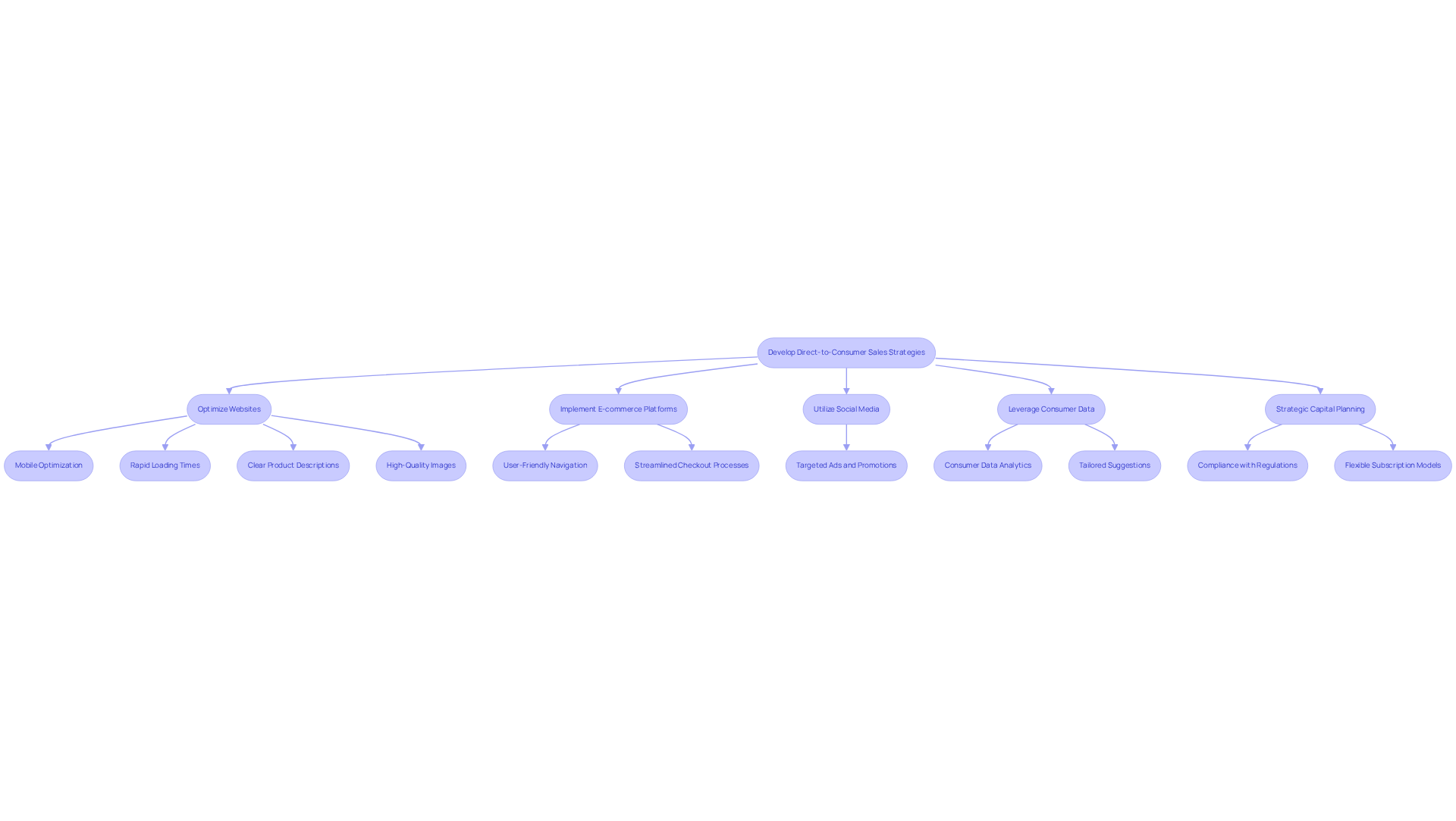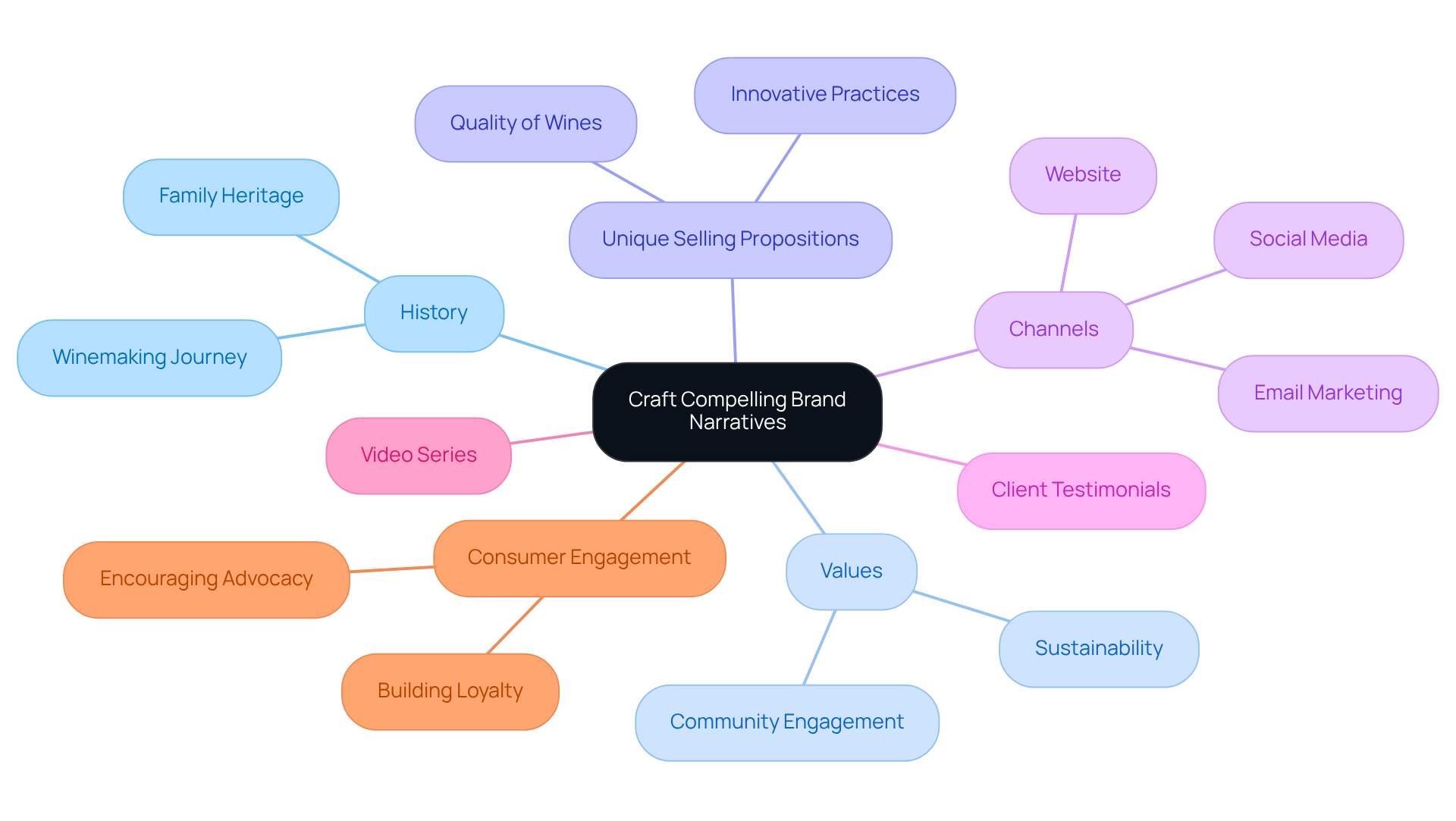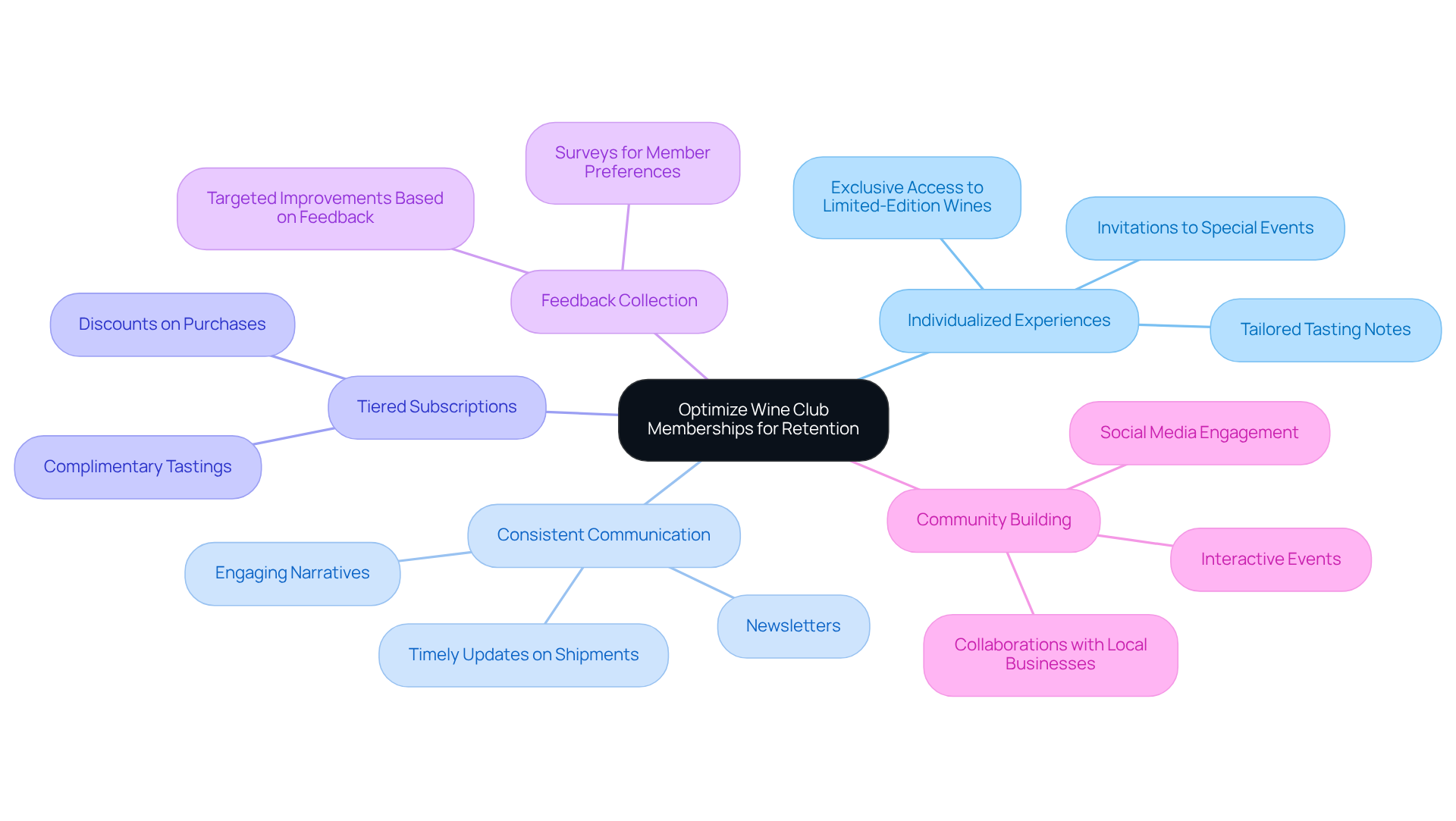Overview
Digital marketing for wineries is anchored in four proven strategies for growth:
- Developing direct-to-consumer sales strategies
- Crafting compelling brand narratives
- Optimizing wine club memberships for retention
- Implementing effective demand generation techniques
By leveraging digital platforms and personalized marketing approaches, wineries can significantly enhance customer engagement and loyalty. This ultimately drives sales and ensures long-term success in a competitive market. The emphasis on these strategies not only establishes a clear path for growth but also positions wineries to thrive amidst industry challenges.
Introduction
The wine industry is undergoing a significant transformation as digital marketing emerges as a crucial component for growth and customer engagement. Wineries that adopt innovative strategies can seize the lucrative direct-to-consumer market, enriching their brand narratives and optimizing wine club memberships. However, as competition escalates, how can vineyards effectively utilize digital tools to differentiate themselves and nurture enduring relationships with their customers? This article delves into four proven strategies that not only drive sales but also cultivate a deeper connection between wineries and their patrons.
Develop Direct-to-Consumer Sales Strategies
To establish effective direct-to-consumer (DTC) sales strategies, vineyards must prioritize by creating a seamless online shopping experience. This entails:
- Optimizing websites for mobile devices
- Ensuring rapid loading times
- Providing clear product descriptions alongside high-quality images
Implementing user-friendly e-commerce platforms is crucial for facilitating easy navigation and streamlined checkout processes. Furthermore, wineries can utilize digital marketing for wineries by leveraging social media platforms to attract visitors to their online stores, showcasing products, and engaging prospective clients through targeted ads and promotions. For instance, a vineyard might initiate a campaign highlighting a limited-time deal on a new wine release, thereby encouraging prompt purchases through a direct link to their online shop.
Moreover, utilizing consumer data analytics equips vineyards with insights into purchasing habits and preferences, which are vital for effective digital marketing for wineries. By offering tailored suggestions based on past purchases, vineyards can significantly enhance the experience for patrons through effective digital marketing for wineries and boost conversion rates. This data-driven strategy not only fosters client loyalty but also empowers vineyards to efficiently adapt to shifting market dynamics through digital marketing for wineries.
Additionally, vineyards should consider strategic capital planning for debt, equity, or acquisition opportunities to ensure compliance with regulations concerning DTC beverage sales, including age verification and shipping laws, thus avoiding potential pitfalls. A successful example is Clif Family Winery's 'The Wine Drop' club, which has experienced a remarkable 244% increase in subscriptions by allowing customers to select their wines. This demonstrates how flexible subscription models can enhance customer engagement and sales. By addressing these critical aspects and focusing on building sustainable DTC channels, producers can significantly refine their DTC sales strategies through effective digital marketing for wineries and foster long-term growth.

Craft Compelling Brand Narratives
Creating an engaging brand story is essential for vineyards to articulate their history, values, and unique selling propositions. This process involves exploring the , encompassing the inspiration for varietals, the complexities of the winemaking process, and the family heritage that shapes the brand. These narratives can be effectively conveyed through various channels, including social media, email marketing, and the vineyard's website, utilizing digital marketing for wineries.
For example, wineries can produce a video series that chronicles the vineyard's journey from grape to glass, highlighting the craftsmanship and passion infused into each bottle. Incorporating client testimonials and personal anecdotes can further enrich the narrative, rendering it more relatable and authentic. The consistent sharing of these stories not only cultivates a strong brand identity but also enhances consumer engagement, motivating visitors to become enthusiastic advocates for the brand.
The importance of storytelling in beverage marketing is underscored by the fact that compelling narratives can lead to increased customer loyalty and sales. Metrics indicate that vineyards leveraging robust brand narratives through digital marketing for wineries experience higher engagement rates, with 27% of new wine club signups originating from digital channels. As consumers increasingly seek genuine connections with brands, establishments that focus on storytelling through digital marketing for wineries are better equipped to succeed in a competitive landscape. Additionally, strategic capital planning is crucial in supporting these storytelling initiatives, enabling producers to invest in marketing efforts that resonate with their audience. By unlocking direct-to-consumer revenue and crafting narratives that resonate, vineyards can convert casual purchasers into dedicated club participants. However, it is vital to avoid common pitfalls, such as failing to establish an emotional connection with the audience, which can diminish the narrative's effectiveness.

Optimize Wine Club Memberships for Retention
To enhance beverage club subscriptions, producers must focus on crafting for their participants. Offering exclusive access to limited-edition wines, tailored tasting notes, and invitations to special events is essential. Consistent communication is crucial; wineries should distribute newsletters that keep subscribers informed about upcoming releases, events, and behind-the-scenes stories, fostering a deeper connection through engaging narratives.
Establishing a tiered subscription framework can further motivate individuals to elevate their plans for improved advantages. Higher-level participants could enjoy complimentary tastings or discounts on further purchases, significantly enhancing their experience. Collecting feedback via surveys enables vineyards to comprehend participant preferences and consistently improve the overall experience.
By fostering a sense of community and exclusivity, vineyards can significantly boost customer loyalty and decrease turnover rates. Statistics suggest that involved individuals are more likely to maintain their subscriptions and participate in events, underscoring the significance of tailored communication and high-quality content in retaining current participants and attracting new ones. As Brandon Harvie notes, "A high retention rate indicates a satisfied and engaged consumer base," highlighting the effectiveness of these strategies. For instance, a vineyard that successfully implemented a tiered membership program saw a 40% increase in member retention, demonstrating the impact of these approaches. Enocap's expertise in strategic capital planning can also assist vineyards in optimizing their membership offerings, ensuring sustainable growth and long-term success.

Implement Effective Demand Generation Techniques
To successfully implement demand generation techniques, vineyards must embrace a comprehensive strategy that prioritizes search engine optimization (SEO), content marketing, and social media advertising. SEO is essential for enhancing online visibility, as optimized websites attract more organic traffic. For instance, establishments focusing on regional SEO can significantly improve their visibility among local enthusiasts, leading to increased foot traffic and online sales.
Producing valuable content, such as blog entries on wine pairings or the intricacies of the winemaking process, not only attracts potential customers but also positions the establishment as an industry authority. This approach aligns with brand narrative development, as compelling stories engage consumers and foster brand loyalty. Research shows that establishments employing content marketing alongside SEO strategies experience higher engagement rates and improved sales performance.
Furthermore, leveraging social media platforms for targeted ad campaigns allows vineyards to connect with specific demographics, particularly younger consumers. A vineyard might create a visually appealing campaign aimed at millennials, promoting tastings or exclusive events. Collaborating with influencers in the beverage industry can further extend reach and enhance credibility, as authentic endorsements resonate strongly with audiences.
Statistics indicate that 27% of new wine club signups come from digital channels, highlighting the necessity of a robust online presence. By employing these integrated techniques, vineyards can use digital marketing for wineries to generate interest, direct traffic to their sales channels, and ultimately increase revenue. Additionally, incorporating strategic capital planning ensures sustainable growth, enabling wineries to thrive in a competitive market. Enocap's proven direct-to-consumer strategies can transform casual buyers into loyal club members, securing long-term success.

Conclusion
Embracing digital marketing is not just beneficial but essential for wineries striving to excel in a competitive landscape. By implementing effective direct-to-consumer sales strategies, crafting compelling brand narratives, optimizing wine club memberships, and utilizing demand generation techniques, vineyards can significantly enhance customer engagement and drive sales growth. These strategies foster a stronger connection with consumers and position wineries to adapt to evolving market dynamics.
The article underscores the necessity of creating a seamless online shopping experience, telling authentic brand stories, personalizing wine club offerings, and leveraging digital channels for demand generation. Each of these elements plays a pivotal role in engaging customers and building loyalty, ultimately leading to increased sales and a robust market presence. Successful examples from the industry, such as Clif Family Winery and tiered membership programs, illustrate the potential for growth when these strategies are effectively executed.
In an ever-changing market, wineries must prioritize digital marketing to connect with their audiences meaningfully. By adopting these proven strategies, vineyards can not only enhance their direct-to-consumer channels but also cultivate lasting relationships with their patrons. The time to innovate and invest in digital marketing is now, ensuring that wineries remain relevant and competitive in the future.
Frequently Asked Questions
What are the key components of effective direct-to-consumer (DTC) sales strategies for vineyards?
Effective DTC sales strategies for vineyards include optimizing websites for mobile devices, ensuring rapid loading times, providing clear product descriptions with high-quality images, and implementing user-friendly e-commerce platforms for easy navigation and streamlined checkout processes.
How can vineyards use social media in their DTC sales strategies?
Vineyards can leverage social media platforms to attract visitors to their online stores, showcase products, and engage prospective clients through targeted ads and promotions, such as campaigns highlighting limited-time deals on new wine releases.
What role does consumer data analytics play in digital marketing for wineries?
Consumer data analytics provides insights into purchasing habits and preferences, allowing vineyards to offer tailored suggestions based on past purchases, which enhances the customer experience and boosts conversion rates.
How can vineyards ensure compliance with regulations concerning DTC beverage sales?
Vineyards should consider strategic capital planning for debt, equity, or acquisition opportunities and ensure compliance with regulations related to age verification and shipping laws to avoid potential pitfalls.
Can you provide an example of a successful DTC sales strategy in the wine industry?
A successful example is Clif Family Winery's 'The Wine Drop' club, which saw a 244% increase in subscriptions by allowing customers to select their wines, demonstrating how flexible subscription models can enhance customer engagement and sales.
What are the benefits of focusing on digital marketing for wineries?
Focusing on digital marketing helps vineyards refine their DTC sales strategies, foster client loyalty, and adapt to shifting market dynamics, ultimately leading to long-term growth.




